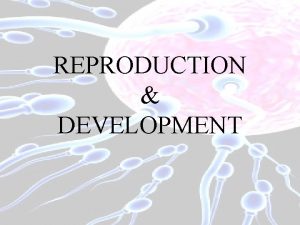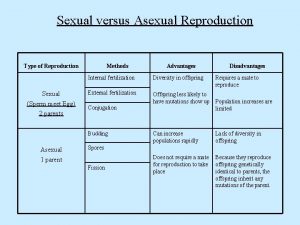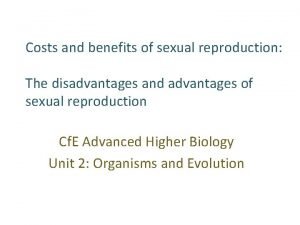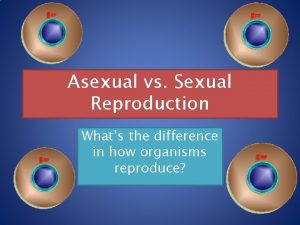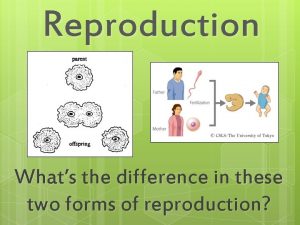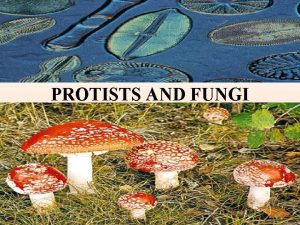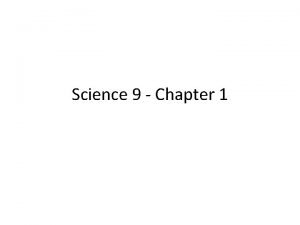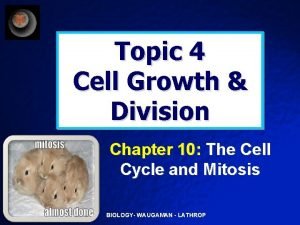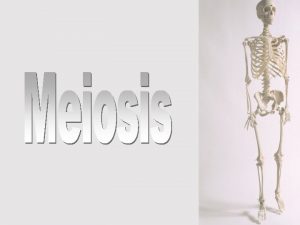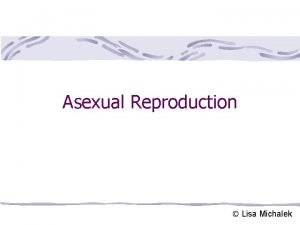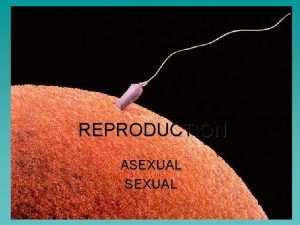Handout 3 Asexual Reproduction Asexual Reproduction Simplified reproduction














- Slides: 14

Handout 3 Asexual Reproduction

Asexual Reproduction - Simplified reproduction - Generally one parent dividing to make two identical cells (mitosis) - Passing of Identical genetic information

6 main types of asexual reproduction a. Binary fission: the parent cell splits in half producing two (2) identical cells through mitosis. (p. 134) Example - bacteria

6 main types of asexual reproduction B. Fragmentation- pieces of the parent organism break off and are dispersed. Each Section is ables to grow a new organism. Example: houseplants grow from cuttings: fungi grown from hyphae

6 main types of asexual reproduction C. Budding - A copy of the genetic material is made, and an outgrowth or bud begins to form through mitosis outside the body of the parent. It continues to grow larger until it eventually breaks away to form a new individual. Example: yeast; hydra

6 main types of asexual reproduction D. Sporulation/Spore Production(p. 166, 154): A spore is a reproductive cell that can grow into a new cell through mitotic cell division. Spores are stored in special spore cases until they are ready to be released. If conditions are favourable, they will grow into individual cells. Example: bread mold (Rhizopus)

6 main types of asexual reproduction e. Parthenogenesis(p. 186): Through mitotic cell division, offspring are produced through unfertilized eggs. Example: some insects (Balsam woolly aphid). Some lizards, some fish.

6 main types of asexual reproduction F. regeneration: A form of asexual reproduction that takes place in some invertebrates from the invertebrate kingdom. This also produces offspring that are identical to the parent. https: //www. youtube. com/watch? v=f 7 c. Xe. Wxxf. D 4 Example: Planaria, a type of flatworm, reproduces itself by dividing in two and regenerating the missing parts. They also have the ability to regenerate injured body parts. https: //www. youtube. com/watch? v=jk 2 RJm 5 RBEk

Sexual Reproduction - Complex reproduction - Two parents to produce offspring - Passing of similar genetic material

Similar stages of reproduction: a. Meiosis (process) for purpose of producing gametes (n) (sex cells known as the egg and the sperm) b. The joining of the male sex cell (sperm) with the female sex cell (egg) through fertilization c. The production of the zygote (2 n) as a result of fertilization. d. The development of the embryo through mitosis into a mature individual

Fertilization = 2 ways 1. External fertilization : In this case, the egg and the sperm meet outside the bodies of the parents. This form is most likely to occur in water dwelling organisms such as fish and frogs. The female usually produces are large number of eggs in an area that is relatively stable in terms of water currents. The male usually swims to the egg cluster and releases his sperm. This process is also referred to as spawning.

2. Internal Fertilization: This method is most suited to land dwelling organisms. The male parent must have a specialized body part (penis) to deliver his sperm cells to the female. Close body contact is required. Examples: humans, cats, earthworms, dogs, mollusks.


Vocab from book a. Anther - where pollen is produced and stored b. Pollen - cases that contain male gametes c. Filament - stalk that supports the anther d. Stamen - male reproductive organs e. Sepals - surround and protect the flower bud f. Petals - colorful structures that attract pollinators g. Pistil - female reproductive organs
 Sexual vs asexual reproduction venn diagram
Sexual vs asexual reproduction venn diagram Asexual reproduction cell division
Asexual reproduction cell division Sexual reproduction and asexual reproduction
Sexual reproduction and asexual reproduction Venn diagram of meiosis and mitosis
Venn diagram of meiosis and mitosis Asexual reproduction lab
Asexual reproduction lab Asexual or sexual reproduction
Asexual or sexual reproduction Sea urchin asexual reproduction
Sea urchin asexual reproduction Parthenogenesis asexual reproduction
Parthenogenesis asexual reproduction Whats sexual reproduction
Whats sexual reproduction Plants and animals reproduction venn diagram
Plants and animals reproduction venn diagram Parthenogenesis
Parthenogenesis Whats asexual reproduction
Whats asexual reproduction Protist
Protist Animal and plant reproduction venn diagram
Animal and plant reproduction venn diagram Asexual reproduction of budding
Asexual reproduction of budding





